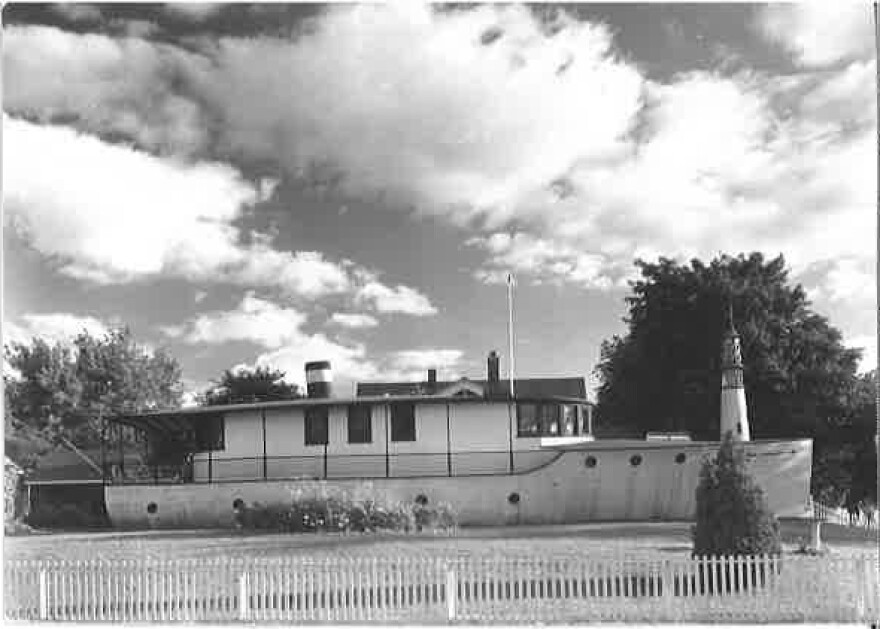On the corner of Cambridge Avenue and Hampshire Avenue on Milwaukee’s east side, there’s a home that stands out.
It’s not a bungalow or a duplex or a high-rise. It’s a boat. It looks like a 70-foot-long yacht, perched on a grassy lawn, facing the Milwaukee River. If that isn’t enough to catch your eye, there is a lighthouse replica on the front lawn.
“It’s super fun to say to people, ‘You know, the boat house?’ ” says Nola Hitchcock Cross, a local attorney and the current owner of the unconventional home. “And they’re like, ‘The boat house? No.’ And then after a pause they say, ‘Oh! The boat house!’”

The boat house is about 550 square feet inside. It looks like a boat but has all the features of a home. There’s a bedroom in the bow, a dining area in the stern, and a living room and galley in the hull.
“It just seems shockingly spacious when you come in,” Nola says.
The boat is lined with porthole windows and maps of the Great Lakes. But this vessel has never been on the water.
A 'Yacht-Bungalow' From The 1920s
Its story goes back to the 1920s. A traveling salesman named Edmund B. Gustorf decided to build what he called a ‘yacht-bungalow.’ One old newspaper article says Gustorf created it as a tourist attraction.
“Some speculation is that his father was a mariner, so that kind of inspired him,” Nola explains. “So it’s not completely clear. It’s fun to imagine who would build something like this.”

The boat house inspired the imagination of our Bubbler Talk question-asker, Eric Brunnich. Eric lives in Sheboygan Falls now, but he remembers visiting the boat house in the 1950s when he was about 8 years old.
“[I was a] very impressionable little kid,” Eric says. “I thought, ‘Hey, that’s cool! Is it like Noah’s Ark or something?’ ”

Sixty-five years later, Eric wants to know more about the boat house and the people who lived there. So, we found one of its longest-staying occupants — local musician and gallerist Paul Finger. He rented the house for 11 years starting in 2000.
'A Piece Of Disneyland'
“It’s kind of like if you were an old lady and you were living in a shoe,” Paul remembers. “It’s a novelty item.”
Paul says people constantly stopped by the boat house. Sometimes they were parents with a car load of kids. Sometimes they were college students trespassing at night to take selfies.
“It’s kind of like living in a piece of Disneyland that somehow broke off and floated away,” says Paul. “People want to see it all hours. You know, people don’t know how to act around an unconventional structure, which is actually a really beautiful thing a lot of time.”
Paul rented the house from its longtime owner William Kortsch. William was a dentist who lived right across the street from the boat house.

The current owner, Nola, was one of William's patients.
“He loved the boat,” she says. “He was in the Navy. I mean, I know this because he would talk to me about this when I couldn’t respond, when my mouth was full of drills and what have you.”
Boat House Tests New Waters As Airbnb
Nola also lives down the street from the boat house, and her son played there with the neighborhood kids growing up. So, when William passed away a couple of years ago and the house was up for sale, Nola and her husband Steve bought it.
“When it really comes down to it, you feel like the boat is part of you, it’s part of the neighborhood,” Nola explains. “It is us, we are it. And so you just don’t want anybody to mess it up.”
Instead of renting the boat house out the old-fashioned way, Nola and Steve put it on Airbnb — a popular vacation rental website.
“Of course [it’s an Airbnb,]” Bubbler Talk questioner Eric Brunnich says. “Of course it would be. That’s gotta be a sign of the times.”

Eric says seeing the boat house as a child in the '50s helped him understand something. In a time of conformity, he realized it’s OK to be different.
It’s almost the exact same sentiment expressed by the couple who owned the boat house in the 1960s. In a newspaper article about them, they’re quoted saying, “There’s so much conformity today. We like things a little bit different.”
Paul Finger, who lived in the boat house for a decade, sees it this way: the boat house, he says "interrupts the grid."
“There’s a different kind of ethos that went into building the boat house,” Paul says. “It was an act of rebellion and it was an act of self-expression, but it was also kind of a social act of love. There was a love in it, there was a care for people. Because, you don’t have to own something to enjoy it.”
Through all the changes the city has seen in past 100 years, the boat house is still there on a quiet street near the Milwaukee River, for anyone to admire and enjoy.
Have a question you'd like WUWM to answer? Submit your query below.
_













